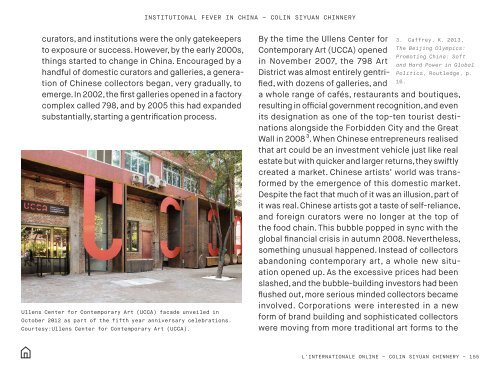DECOLONISING MUSEUMS
decolonisingmuseums_pdf-final
decolonisingmuseums_pdf-final
Create successful ePaper yourself
Turn your PDF publications into a flip-book with our unique Google optimized e-Paper software.
INSTITUTIONAL FEVER IN CHINA – COLIN SIYUAN CHINNERY<br />
curators, and institutions were the only gatekeepers<br />
to exposure or success. However, by the early 2000s,<br />
things started to change in China. Encouraged by a<br />
handful of domestic curators and galleries, a generation<br />
of Chinese collectors began, very gradually, to<br />
emerge. In 2002, the first galleries opened in a factory<br />
complex called 798, and by 2005 this had expanded<br />
substantially, starting a gentrification process.<br />
Ullens Center for Contemporary Art (UCCA) facade unveiled in<br />
October 2012 as part of the fifth year anniversary celebrations.<br />
Courtesy:Ullens Center for Contemporary Art (UCCA).<br />
By the time the Ullens Center for<br />
Contemporary Art (UCCA) opened<br />
in November 2007, the 798 Art<br />
District was almost entirely gentrified,<br />
with dozens of galleries, and<br />
16.<br />
a whole range of cafés, restaurants and boutiques,<br />
resulting in official government recognition, and even<br />
its designation as one of the top-ten tourist destinations<br />
alongside the Forbidden City and the Great<br />
Wall in 2008 3. When Chinese entrepreneurs realised<br />
that art could be an investment vehicle just like real<br />
estate but with quicker and larger returns, they swiftly<br />
created a market. Chinese artists’ world was transformed<br />
by the emergence of this domestic market.<br />
Despite the fact that much of it was an illusion, part of<br />
it was real. Chinese artists got a taste of self-reliance,<br />
and foreign curators were no longer at the top of<br />
the food chain. This bubble popped in sync with the<br />
global financial crisis in autumn 2008. Nevertheless,<br />
something unusual happened. Instead of collectors<br />
abandoning contemporary art, a whole new situation<br />
opened up. As the excessive prices had been<br />
slashed, and the bubble-building investors had been<br />
flushed out, more serious minded collectors became<br />
involved. Corporations were interested in a new<br />
form of brand building and sophisticated collectors<br />
were moving from more traditional art forms to the<br />
3. Caffrey, K. 2013,<br />
The Beijing Olympics:<br />
Promoting China: Soft<br />
and Hard Power in Global<br />
Politics, Routledge, p.<br />
L’INTERNATIONALE ONLINE – COLIN SIYUAN CHINNERY – 155


